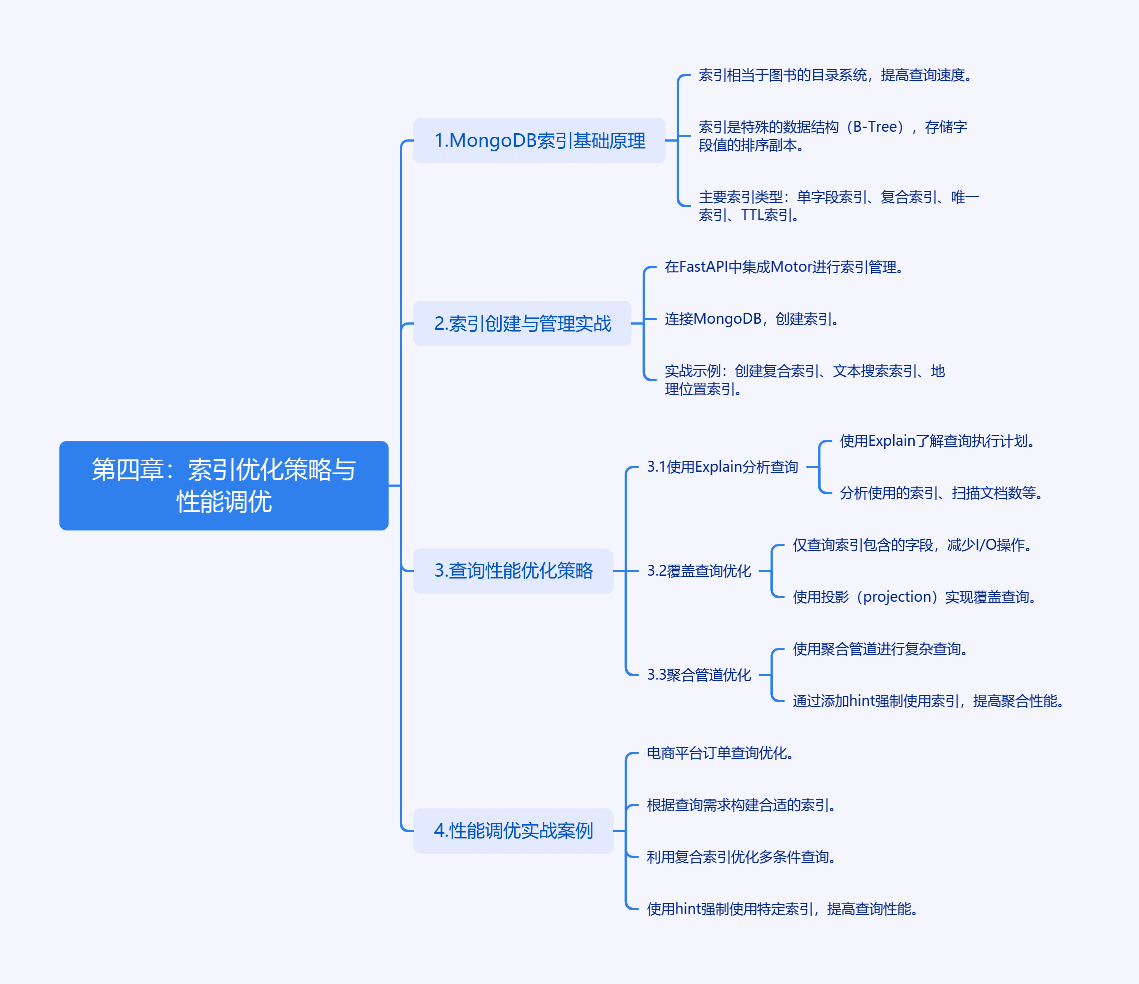title: MongoDB索引优化的艺术:从基础原理到性能调优实战
date: 2025/05/21 18:08:22
updated: 2025/05/21 18:08:22
author: cmdragon
excerpt:
MongoDB索引优化与性能调优的核心策略包括:索引基础原理,如单字段、复合、唯一和TTL索引;索引创建与管理,通过FastAPI集成Motor实现;查询性能优化,使用Explain分析、覆盖查询和聚合管道优化;实战案例,如电商平台订单查询优化;常见报错解决方案,如索引创建失败、查询性能下降和文档扫描过多问题。这些策略能显著提升查询速度和系统性能。
categories:
- 后端开发
- FastAPI
tags:
- MongoDB
- 索引优化
- 性能调优
- FastAPI
- 查询分析
- 聚合管道
- 错误处理


扫描二维码
关注或者微信搜一搜:编程智域 前端至全栈交流与成长
探索数千个预构建的 AI 应用,开启你的下一个伟大创意:https://tools.cmdragon.cn/
第四章:索引优化策略与性能调优
1. MongoDB索引基础原理
在MongoDB中,索引相当于图书的目录系统。当集合存储量达到百万级时,合理的索引设计能让查询速度提升10-100倍。索引本质上是特殊的数据结构(B-Tree),存储着字段值的排序副本。
主要索引类型:
python
# 单字段索引示例
async def create_single_index():
await db.products.create_index("name")
# 复合索引示例(注意字段顺序)
async def create_compound_index():
await db.orders.create_index([("user_id", 1), ("order_date", -1)])
# 唯一索引示例
async def create_unique_index():
await db.users.create_index("email", unique=True)
# TTL索引示例(自动过期)
async def create_ttl_index():
await db.logs.create_index("created_at", expireAfterSeconds=3600)2. 索引创建与管理实战
在FastAPI中集成Motor进行索引管理的最佳实践:
python
from fastapi import APIRouter
from motor.motor_asyncio import AsyncIOMotorClient
from pydantic import BaseModel
router = APIRouter()
class Product(BaseModel):
name: str
price: float
category: str
# 连接MongoDB
client = AsyncIOMotorClient("mongodb://localhost:27017")
db = client["ecommerce"]
@router.on_event("startup")
async def initialize_indexes():
# 创建复合索引
await db.products.create_index([("category", 1), ("price", -1)])
# 文本搜索索引
await db.products.create_index([("name", "text")])
# 地理位置索引(需2dsphere)
await db.stores.create_index([("location", "2dsphere")])3. 查询性能优化策略
3.1 使用Explain分析查询
python
async def analyze_query():
cursor = db.products.find({"price": {"$gt": 100}})
explain = await cursor.explain()
print(f"使用的索引:{explain['queryPlanner']['winningPlan']['inputStage']['indexName']}")
print(f"扫描文档数:{explain['executionStats']['totalDocsExamined']}")3.2 覆盖查询优化
python
async def covered_query():
# 只查询索引包含的字段
projection = {"_id": 0, "name": 1, "category": 1}
cursor = db.products.find({"category": "electronics"}, projection)
async for doc in cursor:
print(doc)3.3 聚合管道优化
python
async def optimized_aggregation():
pipeline = [
{"$match": {"status": "completed"}},
{"$sort": {"total_amount": -1}},
{"$group": {
"_id": "$user_id",
"total_spent": {"$sum": "$total_amount"}
}},
{"$limit": 10}
]
# 添加hint强制使用索引
cursor = db.orders.aggregate(pipeline).hint([("status", 1), ("total_amount", -1)])
results = await cursor.to_list(length=10)
return results4. 性能调优实战案例
电商平台订单查询优化:
python
class OrderQuery(BaseModel):
user_id: str
start_date: datetime
end_date: datetime
min_amount: float = None
@router.post("/orders/search")
async def search_orders(query: OrderQuery):
# 构建查询条件
conditions = {
"user_id": query.user_id,
"order_date": {"$gte": query.start_date, "$lte": query.end_date}
}
if query.min_amount:
conditions["total_amount"] = {"$gte": query.min_amount}
# 使用复合索引优化查询
projection = {"_id": 0, "order_id": 1, "total_amount": 1, "items": 1}
cursor = db.orders.find(
conditions,
projection
).sort("order_date", -1).hint([("user_id", 1), "order_date", -1)])
return await cursor.to_list(length=100)5. 课后Quiz
Q1:以下哪种索引顺序更适合查询db.orders.find({"status":"shipped", "total":{$gt:100}}).sort("ship_date":1)?
A) (status, total, ship_date)
B) (status, ship_date, total)
C) (ship_date, status, total)
正确答案:A
解析:等值查询字段(status)应放在最前,范围查询字段(total)在后,排序字段(ship_date)在最后可以避免内存排序
Q2:如何判断查询是否使用了覆盖索引?
A) 检查执行时间
B) 查看explain输出中的totalDocsExamined
C) 观察返回字段是否都在索引中
正确答案:C
解析:覆盖查询需要所有返回字段都包含在索引中,且查询不包含_id字段或显式排除
6. 常见报错解决方案
报错1:OperationFailure: Error creating index
原因:尝试在已存在重复值的字段上创建唯一索引
解决:
python
# 先清理重复数据
async def clean_duplicate_emails():
pipeline = [
{"$group": {"_id": "$email", "dups": {"$push": "$_id"}, "count": {"$sum": 1}}},
{"$match": {"count": {"$gt": 1}}}
]
async for dup in db.users.aggregate(pipeline):
await db.users.delete_many({"_id": {"$in": dup["dups"][1:]}})报错2:查询性能突然下降
可能原因:索引碎片化或统计信息过期
解决:
python
# 重建索引
async def rebuild_indexes():
await db.products.drop_index("category_1_price_-1")
await db.products.create_index([("category", 1), ("price", -1)])报错3:Executor error during find command: Too many documents scanned
原因:查询未命中索引或索引选择不当
解决:
- 使用explain分析查询计划
- 添加适当的索引
- 优化查询条件,减少扫描范围
运行环境要求:
- Python 3.8+
- FastAPI==0.78.0
- motor==3.1.1
- pydantic==1.10.7
- uvicorn==0.18.2
安装命令:
bash
pip install fastapi==0.78.0 motor==3.1.1 pydantic==1.10.7 uvicorn==0.18.2余下文章内容请点击跳转至 个人博客页面 或者 扫码关注或者微信搜一搜:编程智域 前端至全栈交流与成长,阅读完整的文章:MongoDB索引优化的艺术:从基础原理到性能调优实战 | cmdragon's Blog
往期文章归档:
- 解锁FastAPI与MongoDB聚合管道的性能奥秘 | cmdragon's Blog
- 异步之舞:Motor驱动与MongoDB的CRUD交响曲 | cmdragon's Blog
- 异步之舞:FastAPI与MongoDB的深度协奏 | cmdragon's Blog
- 数据库迁移的艺术:FastAPI生产环境中的灰度发布与回滚策略 | cmdragon's Blog
- 数据库迁移的艺术:团队协作中的冲突预防与解决之道 | cmdragon's Blog
- 驾驭FastAPI多数据库:从读写分离到跨库事务的艺术 | cmdragon's Blog
- 数据库事务隔离与Alembic数据恢复的实战艺术 | cmdragon's Blog
- FastAPI与Alembic:数据库迁移的隐秘艺术 | cmdragon's Blog
- 飞行中的引擎更换:生产环境数据库迁移的艺术与科学 | cmdragon's Blog
- Alembic迁移脚本冲突的智能检测与优雅合并之道 | cmdragon's Blog
- 多数据库迁移的艺术:Alembic在复杂环境中的精妙应用 | cmdragon's Blog
- 数据库事务回滚:FastAPI中的存档与读档大法 | cmdragon's Blog
- Alembic迁移脚本:让数据库变身时间旅行者 | cmdragon's Blog
- 数据库连接池:从银行柜台到代码世界的奇妙旅程 | cmdragon's Blog
- 点赞背后的技术大冒险:分布式事务与SAGA模式 | cmdragon's Blog
- N+1查询:数据库性能的隐形杀手与终极拯救指南 | cmdragon's Blog
- FastAPI与Tortoise-ORM开发的神奇之旅 | cmdragon's Blog
- DDD分层设计与异步职责划分:让你的代码不再"异步"混乱 | cmdragon's Blog
- 异步数据库事务锁:电商库存扣减的防超卖秘籍 | cmdragon's Blog
- FastAPI中的复杂查询与原子更新指南 | cmdragon's Blog
- 深入解析Tortoise-ORM关系型字段与异步查询 | cmdragon's Blog
- FastAPI与Tortoise-ORM模型配置及aerich迁移工具 | cmdragon's Blog
- 异步IO与Tortoise-ORM的数据库 | cmdragon's Blog
- FastAPI数据库连接池配置与监控 | cmdragon's Blog
- 分布式事务在点赞功能中的实现 | cmdragon's Blog
- Tortoise-ORM级联查询与预加载性能优化 | cmdragon's Blog
- 使用Tortoise-ORM和FastAPI构建评论系统 | cmdragon's Blog
- 分层架构在博客评论功能中的应用与实现 | cmdragon's Blog
- 深入解析事务基础与原子操作原理 | cmdragon's Blog
- 掌握Tortoise-ORM高级异步查询技巧 | cmdragon's Blog
- FastAPI与Tortoise-ORM实现关系型数据库关联 | cmdragon's Blog
- Tortoise-ORM与FastAPI集成:异步模型定义与实践 | cmdragon's Blog
- 异步编程与Tortoise-ORM框架 | cmdragon's Blog
- FastAPI数据库集成与事务管理 | cmdragon's Blog
- XML Sitemap